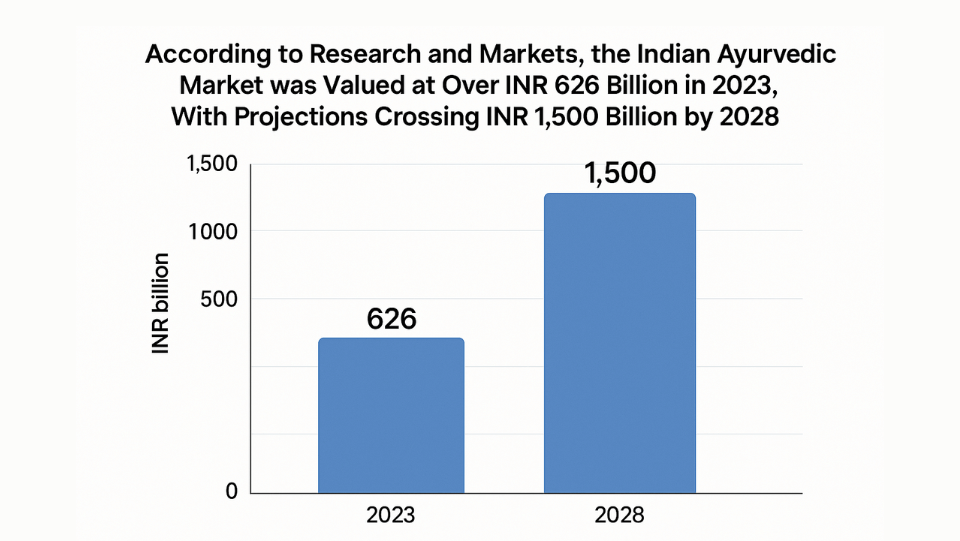Table Of Content
- Why Sell Ayurveda Products Online?
- Choosing Your Niche in Ayurveda
- Validate Demand
- Finding Reliable Manufacturers and Suppliers
- Choosing the Right E-commerce Platform
- Shopify
- WooCommerce
- Amazon India
- Nykaa, 1MG, Netmeds
- Building Trust and Brand Storytelling
- Marketing Strategies for Selling Ayurveda Online
- Social Media Marketing
- Influencer Marketing
- SEO & Content Marketing
- Paid Ads
- Payment Gateways and Fulfillment
- What can I find on Webverbal?
- How often is the content updated?
- Why choose Webverbal for information?
India’s Ayurveda market is booming like never before. From herbal supplements and organic skincare to traditional wellness solutions, Ayurveda has stepped confidently into the digital world. Selling Ayurveda products online is no longer just an idea—it’s a thriving business opportunity.
But let’s be honest—while the market is big, the challenges are equally significant:
- Complex regulations from FSSAI, AYUSH, and other bodies
- Fierce competition, both local and global
- Building trust for health-related products online
- Educating customers unfamiliar with Ayurveda terms and benefits
I’ve been navigating this landscape myself as a founder, and I know firsthand how tricky—and rewarding—it can be. That’s why I’ve created this real founder’s guide to selling Ayurveda products online in India in 2025.
Whether you’re just starting or looking to expand your Ayurvedic brand, this guide will help you:
- Find your niche and profitable products
- Understand the legal rules for Ayurvedic e-commerce
- Choose reliable suppliers and manufacturers
- Pick the right e-commerce platform for Ayurveda
- Optimize your brand storytelling and digital marketing
- Build customer trust and scale sustainably
Let’s dive in and explore how to turn Ayurveda’s ancient wisdom into a profitable modern business.ting or looking to expand your Ayurvedic brand, this guide will help you:
Why Sell Ayurveda Products Online?
Selling Ayurveda products online is a massive opportunity because:
- Global Demand is Soaring: Ayurveda is becoming a mainstream wellness trend worldwide. Terms like Ashwagandha, Turmeric, and Triphala are now global buzzwords.
- High Margins: Many Ayurvedic products carry excellent profit margins, especially niche, premium items.
- Digital Convenience: Consumers want authentic products directly from trusted brands rather than buying from local, unverified stores.
- Brand Storytelling Matters: Ayurveda brands can thrive by telling powerful stories rooted in Indian tradition and holistic wellness.
Choosing Your Niche in Ayurveda
Don’t try to sell every Ayurveda product under the sun. The key to success is niche focus.
Popular niches in Ayurveda include:
Herbal Supplements — Ashwagandha, Brahmi, Shatavari, etc.
Natural Skincare — Turmeric creams, sandalwood packs, Kumkumadi oils.
Haircare — Bhringraj oils, herbal shampoos, anti-dandruff treatments.
Women’s Health — Hormonal balance, prenatal care.
Immunity Boosters — Chyawanprash, Tulsi drops.
Stress & Sleep Aids — Herbal teas, essential oils.
Validate Demand
- Check search volumes on Google Trends for herbs like “Ashwagandha” or “Kumkumadi oil.”
- Look at Amazon Bestsellers in “Ayurveda” categories.
- Join Ayurveda communities on Facebook, Reddit, or WhatsApp for real-time feedback.
Tip: Start small, validate demand, and scale up once you see traction.
Let’s dive in and explore how to turn Ayurveda’s ancient wisdom into a profitable modern business.
Why Ayurveda is Booming Online?

According to Research and Markets, the Indian Ayurvedic market was valued at over INR 626 billion in 2023, with projections crossing INR 1,500 billion by 2028.
Here’s why:
- People want chemical-free alternatives.
- Millennials trust natural solutions for wellness.
- Post-COVID, immunity became a household priority.
- Ayurveda carries ancient legitimacy.
- Platforms like Amazon and Flipkart report massive YoY growth in herbal supplements, personal care, and immunity boosters.
The D2C Ayurveda Revolution: Real Examples
Some of India’s top D2C brands have cracked the code:
Kapiva → Started with basic juices, now offers superfoods and skin care. Kapiva used social commerce, regional content, and influencer campaigns to build trust and scale.
Dabur’s D2C push → While Dabur is a legacy player, they’ve launched daburshop.com, creating a direct relationship with younger consumers.
The Ayurveda Co. (TAC) → Achieved significant traction with affordable luxury positioning and brilliant Instagram marketing. TAC combines storytelling with clinically tested claims.
Zandu Care → From a traditional brand to a full-fledged ecommerce presence, with personalized recommendations and WhatsApp support.
Baidyanath → Leverages Amazon and its own ecommerce store, but also YouTube videos in Hindi explaining benefits of various formulations.
These brands prove multi-channel is the secret — not just depending on Amazon, but building D2C websites, social commerce channels, and even offline pop-up experiences.
Legal and Regulatory Requirements
Let’s talk compliance. Selling Ayurveda isn’t like selling T-shirts online.
Here’s what you must ensure:
- Ayush License → Mandatory for manufacturing Ayurvedic products.
- FSSAI License → Needed if you’re selling Ayurvedic supplements or edible items.
- Labeling Compliance → Labels must adhere to Drug and Cosmetic Act regulations.
- Advertising Norms → You can’t make medical cure claims without scientific evidence.
- GST Registration → Required if turnover crosses the threshold.
Ignoring these rules can sink your business overnight.
Finding Reliable Manufacturers and Suppliers
Your success depends on the quality and authenticity of your Ayurvedic products. Here’s how to choose partners wisely:
Look for manufacturers with:
- GMP and FSSAI/AYUSH certifications.
- Good reputation and references.
- In-house R&D and lab testing.
Check marketplaces like IndiaMART for initial leads, but always visit factories personally or get samples tested.
Popular Ayurvedic manufacturers in India:
- Baidyanath Ayurved
- Dabur Ayurvedic R&D Centers
- AVP Ayurveda
- Sitaram Ayurveda
- J&J Dechane Labs
Tip: Small batch manufacturers often offer white-label solutions for startups.
Choosing the Right E-commerce Platform
Selling Ayurveda products online gives you several options:
Shopify
Pros:
- Easy to set up.
- Great for brand storytelling.
- Multiple Ayurveda brands use Shopify globally.
Cons:
- Monthly subscription fees.
WooCommerce
Pros:
- Free if you have WordPress.
- Full ownership of your website.
Cons:
- More technical setup required.
Amazon India
Pros:
- Huge traffic and trust.
- Ready customer base.
Cons:
- Competition is fierce.
- Lower margins due to fees.
Nykaa, 1MG, Netmeds
These platforms specialize in wellness and Ayurveda:
Pros:
- Credibility in wellness categories.
- Trusted for health products.
Cons:
- High commission fees.
- Approval and listing process is strict.
Building Trust and Brand Storytelling
Selling Ayurveda products online is all about trust.
Tell Your Brand Story:
- Why did you start this Ayurveda brand?
- What are your brand values?
- Do you use authentic ingredients from specific regions in India?
Use Visuals:
- Show images of herbs, factories, lab testing, and founders.
- Feature certifications and lab test reports on your website.
Educate Customers:
- Create blogs or videos explaining:
- What is Ashwagandha?
- Benefits of Kumkumadi oil.
- How to choose authentic Ayurveda products.
Tip: Content marketing is a powerful tool for Ayurveda brands. Help your customers understand Ayurveda rather than just selling to them.
Marketing Strategies for Selling Ayurveda Online
Social Media Marketing
Instagram and YouTube are gold mines for Ayurveda brands. Share:
- DIY skincare recipes.
- Health benefits of specific herbs.
- Behind-the-scenes manufacturing videos.
Influencer Marketing
Tie up with health coaches, yoga instructors, or Ayurveda doctors to build credibility.
SEO & Content Marketing
- Write blogs about:
- Best herbs for stress relief.
- Differences between classical and proprietary Ayurveda products.
- Target long-tail keywords like “Buy Kumkumadi oil online in India.”
Paid Ads
- Facebook & Instagram: Highly visual platform for Ayurveda products.
- Google Ads: Great for targeting intent-based searches.
Payment Gateways and Fulfillment
Since many Ayurveda products are relatively high-ticket, choose trusted payment gateways like:
- Razorpay
- PayU
- CCAvenue
Ensure your logistics partner allows COD and smooth delivery even in Tier-2 and Tier-3 cities.
Product Strategy: How to Stand Out
Here’s how top founders make Ayurveda products stand out:
- Transparency is your superpower. Show ingredient lists. Explain benefits. Use real sourcing stories.
- Trust signals are non-negotiable. COD options, visible return policies, founder stories.
- Modern formats sell well. Powders, gummies, effervescent tablets appeal to urban buyers.
- Solve real-life problems. Focus on categories like sleep, stress, weight loss, PCOS — with Ayurvedic solutions.
- Embrace regional languages. A Tamil or Hindi product page can drive higher conversions in Tier-2 markets.
Digital Marketing Playbook for Ayurveda Brands
- Content Marketing
- Blogs on immunity, herbs, seasonal wellness tips.
- Founder storytelling.
- User-generated reviews, especially video testimonials.
- Influencer Collaborations
- Collaborate with yoga teachers, Ayurveda practitioners, and even doctors.
- Micro-influencers in regional languages are incredibly powerful.
- Social Commerce
- Platforms like Instagram Shops and WhatsApp Business.
- Live selling sessions explaining products.
- Paid Ads
- Google Search → high-intent queries like “best ayurvedic medicine for hair fall.”
- Facebook & Instagram → short video ads highlighting real results.
- Community Building
- Closed Facebook Groups.
- Telegram channels sharing wellness tips.
- Email newsletters with seasonal Ayurveda advice.
The Multi-Channel Advantage
Don’t just depend on one channel. Successful brands:
- Sell on marketplaces (Amazon, Flipkart)
- Build a strong D2C website
- Run social commerce via WhatsApp, Instagram, Facebook Shops
- Use regional marketplaces like Meesho for Bharat markets
- Explore export opportunities if compliance allows
The Ayurveda Co. started on marketplaces but built a loyal customer base by owning their customer data through D2C. That’s where repeat purchases — and higher margins — live.
Challenges to Watch Out For
- Rising ad costs on Meta and Google.
- Misinformation leading to distrust.
- Fake brands selling spurious products.
- Rising competition from traditional giants and new D2C players.
- Consumers demanding proof of efficacy.
The secret sauce is building brand trust and transparency. That’s how you’ll stand out in a crowded market.
My Final Founder Advice
Ayurveda isn’t just another product category. It’s a promise of health. Your brand must reflect that seriousness.
Here’s my personal mantra for building an Ayurveda brand:
- Educate your customers, don’t just sell.
- Stay 100% compliant.
- Use storytelling to connect.
- Build multiple channels so you’re never dependent on one platform.
- Listen to your customers relentlessly.
In a country where health is both ancient wisdom and modern necessity, your opportunity is huge. Build with honesty — and you’ll win.
Selling ayurveda products online is booming in 2025, driven by conscious consumers, digital convenience, and India’s rich wellness heritage. But remember—it’s not just about putting herbal powders on a website.
Successful Ayurvedic founders focus on:
- Authentic product sourcing and quality
- Compliance with India’s strict health regulations
- Building trust through storytelling and education
- Smart digital marketing to keep customer acquisition costs low
- Delivering a premium experience that matches Ayurvedic values
As a founder, you’re not simply selling products—you’re sharing thousands of years of Indian wellness wisdom with the world. Start small, stay compliant, and tell your story authentically. With consistency, your Ayurveda brand can grow as naturally as the herbs it’s built upon.




